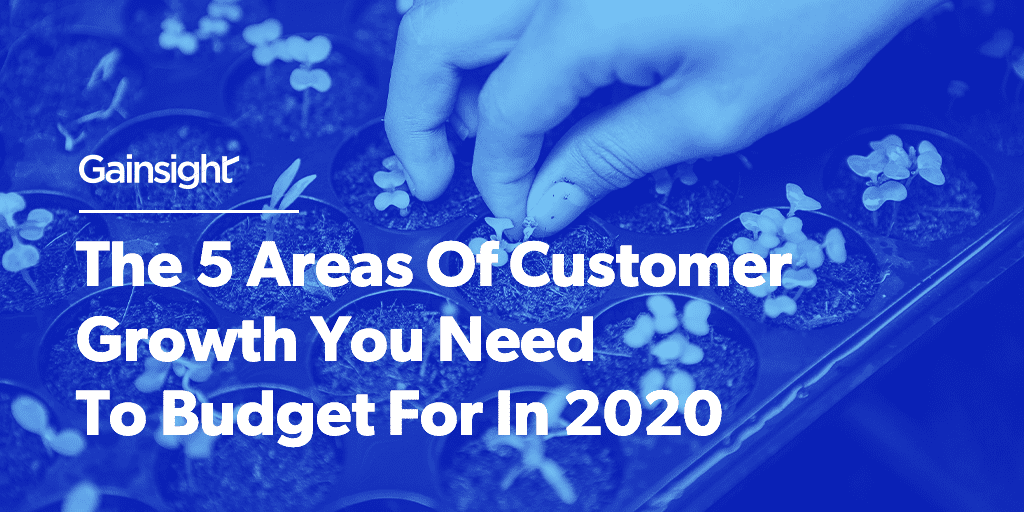The new year is right around the corner, which means time is running out to get your budget in order. Customer growth is the goal of every business, but budgeting for a growth-driven strategy in 2020 is as difficult as ever.
Customer growth is constantly evolving as new advancements in technology are made. This means that what worked last year may not be enough to keep up this year.
With that in mind, I’ve put together a list of five areas to budget for in order to accelerate customer growth for the upcoming year. Don’t let underbudgeting destroy your growth strategy!
How to budget for customer success
The key to budgeting for customer success is agile planning. Understandably, this can seem difficult to do when trying to create a concrete budget.
One of the workarounds to this problem is to create a budget that conforms to your goals, not the other way around. This begins with defining whether your budget is modeled around an entering or an exiting cost target—maybe you want to have a budget at X%, but first, that could require starting at a budget of Y%.
From there, you can take into account your major initiatives for the new year. When it comes to budgeting for customer success, this should include initiatives such as:
- Tracking growth drivers: How much return do you see for your efforts? Is it worth it to allocate part of your budget to these efforts?
- Providing enough resources: Your CSM team has a large task on their hands. Investing in operations allows CSM teams to do their job more effectively.
- Investing in systems: Innovation is what separates us from the cavemen. Utilizing systems allows room for experimentation in your budgeting, giving you the ability to scale faster.
How to budget for customer experience
89% of businesses are expected to compete mainly on customer experience, which makes budgeting for your customer experience initiatives important if you want to stay competitive.
Utilize your CX platform to gain insight into how your customers are faring with your product. Do they understand how to use your features? Are they kept up-to-date when new capabilities come out? Does your onboarding process leave them feeling confident about your product?
Allow these metrics to guide your budget for customer experience. Investing in systems that fill in the gaps in your CX will help get your customers quicker to value and your business quicker to its target goals.
How to budget for product experience
Figuring out how to budget for product experience can be one of the most difficult parts of budget forecasting. After all, users don’t tell you they don’t like your product—they just stop using it.
So, how do you know what you need to budget for?
Well, by using your PX platform to gather product data. It’s up to you to identify negative trends and figure out what improvements need to be made in the upcoming year. From there, you can decide how much you’ll need to allocate to your PX goals.
Don’t be afraid to reach out to your IT team when budgeting for product experience. Often, they can give you a more in-depth view of which way the product will be moving next year—will you need to buy new software? Will your existing software be required to support new initiatives?
Consulting with IT also has the added benefit of avoiding any messy scenarios such as the question of “whose budget is this coming from?”. You never know—you may have more room in your budget than you think!
How to budget for renewal management
Like death and taxes, churn is an unavoidable fact of life. But at least we have ice cream.

Oh yeah, and voluntary churn.
Put that ice cream away and get back to work, because voluntary churn is churn that can be prevented! Unlike involuntarily churn, which is often caused by things outside of your influence (such as a customer going out of business), voluntary churn is well within your power to control.
This is the kind of churn you want to focus on when budgeting for the new year.
Segment your voluntary churn and then tune into your renewal management platform. Where are your customers falling off? Are you devoting enough time and energy to at-risk renewals?
The name of the game here is prevention. You want to identify what exactly is causing voluntary churn. Once you know what is causing each segment to drop off, you’ll have a better idea of what you need to budget for in the new year.
How to budget for a customer data platform
A good growth strategy begins with data. You may be thinking, “I know that. I talk to my customers and survey them all the time!” While that is an important part of it, it’s like saying you can cook when all you can really make is spaghetti (it’s okay if that’s you, I once burned a pot of water).
Customer relationships aren’t so simple anymore—in fact, they’re unbelievably complex. Customers engage with your product in several different contexts and you can’t treat all of these engagements the same.
When budgeting for a customer data platform, it’s important to take stock of how you’re currently interacting with your customers.
Are your engagements nuanced and personalized, or do you rely on generalized reports to gather information? Are you experiencing problems in any of the 4 previous areas of this article that are defying your best efforts to solve them?
If so, you may need a more thorough customer data platform. Identify where it is your current system is lacking and then use that information to search for one that will fulfill those needs. But don’t stop there—before putting together a budget, make sure you understand exactly how this new system will positively influence your customer success rates.
Budgeting starts with data
Budget forecasting for growth is largely reliant on data. While you may know the general areas you need to budget for in the new year, that’s usually not enough for a budget plan—in fact, that could be a recipe for disaster.
Instead, remember these three key points when budgeting for the future:
- Things don’t always go as planned. Create an agile budget that can withstand the tides of your upcoming initiatives.
- Understand your shortcomings as intimately as possible. Don’t be afraid to talk to your team or teams in other departments. Often, they’ll be able to provide insight you wouldn’t get on your own.
- Only invest in solutions you understand. Your budget should be used intelligently. If you want to purchase X, then you should understand the impact it will have on Y.
Got questions about budgeting for customer growth? Ask the experts in this webinar Thursday, September 26.
